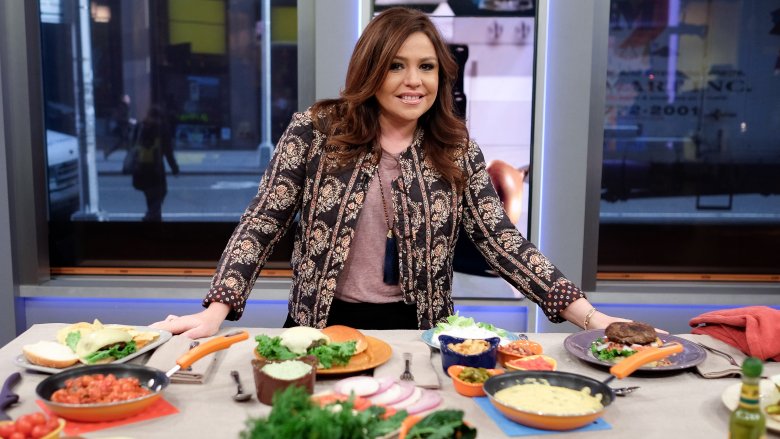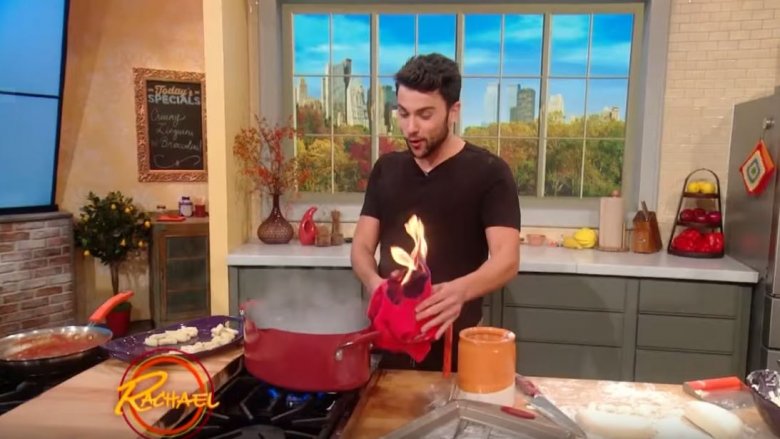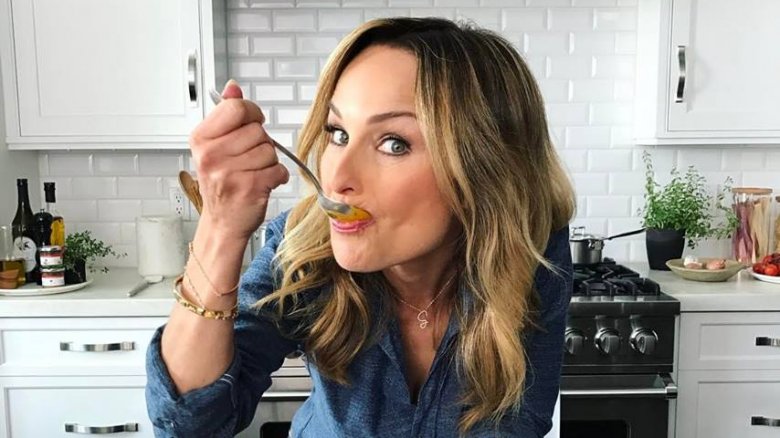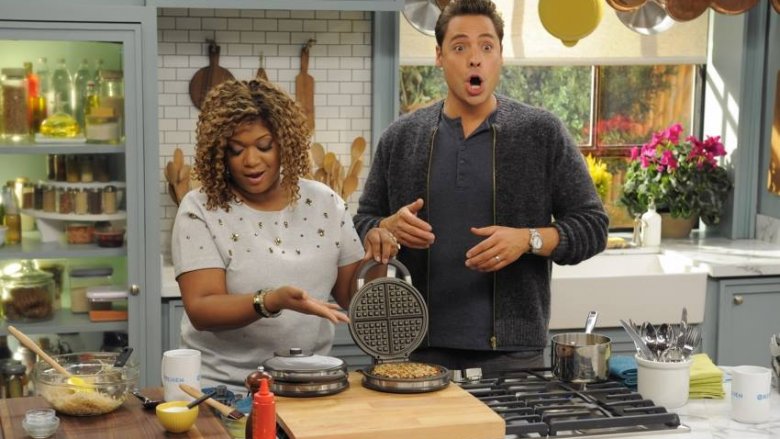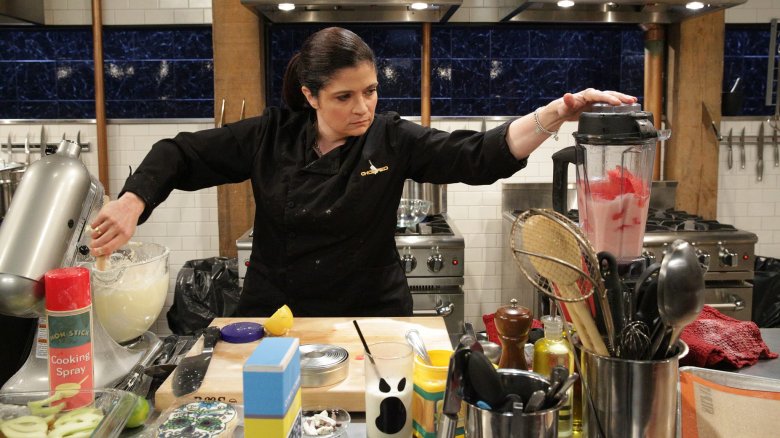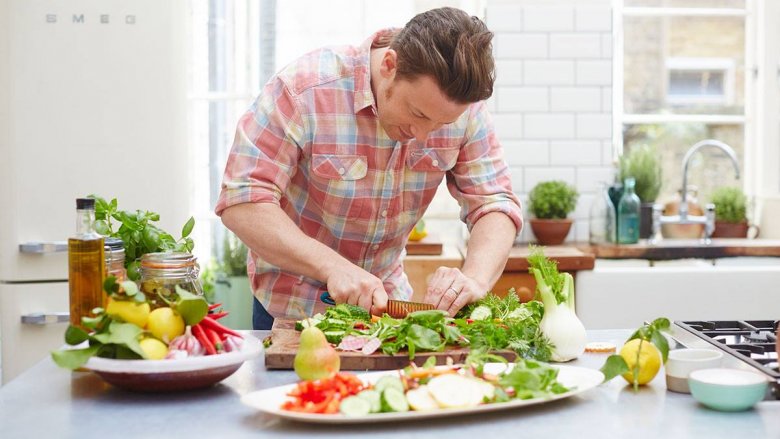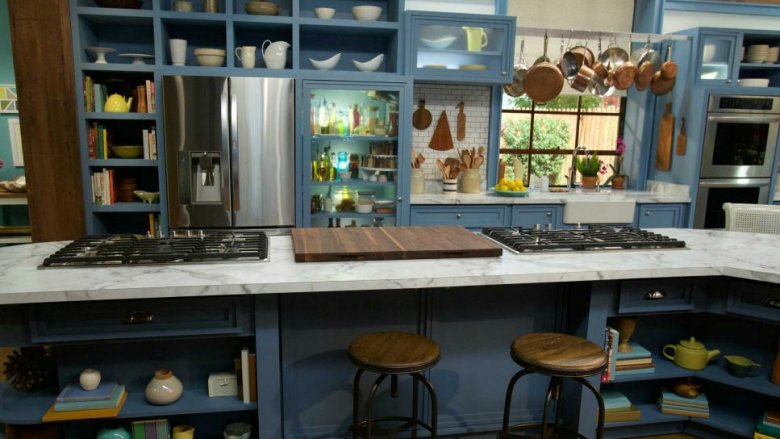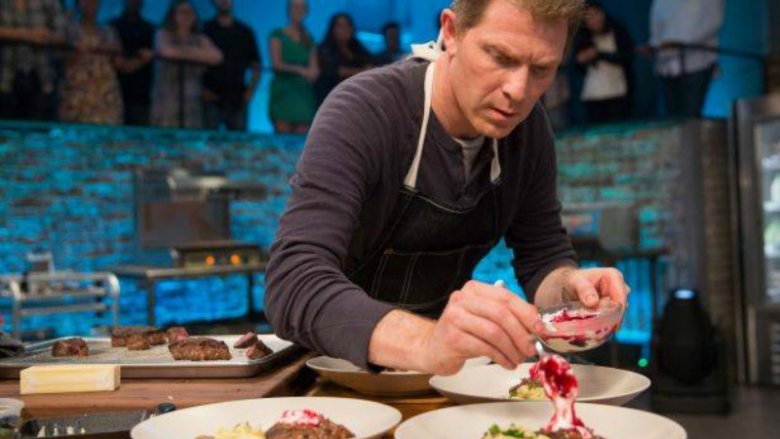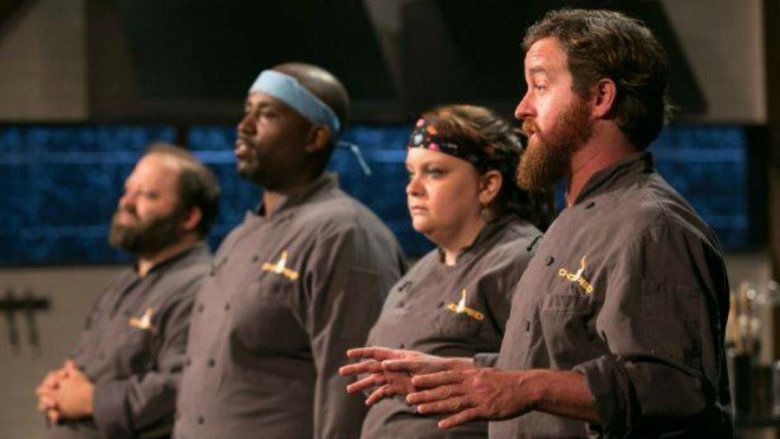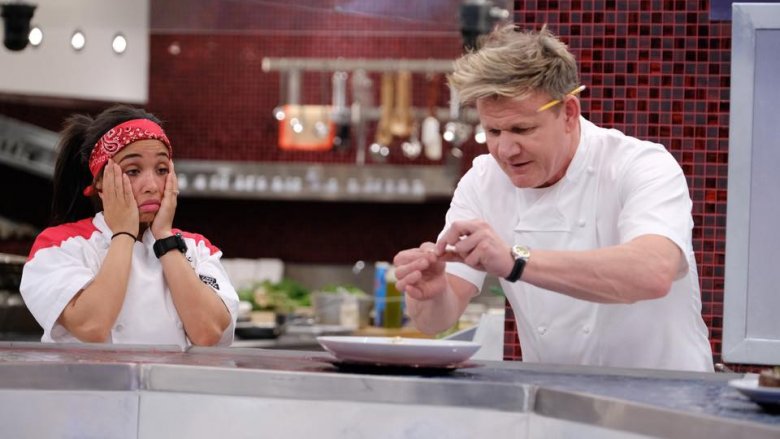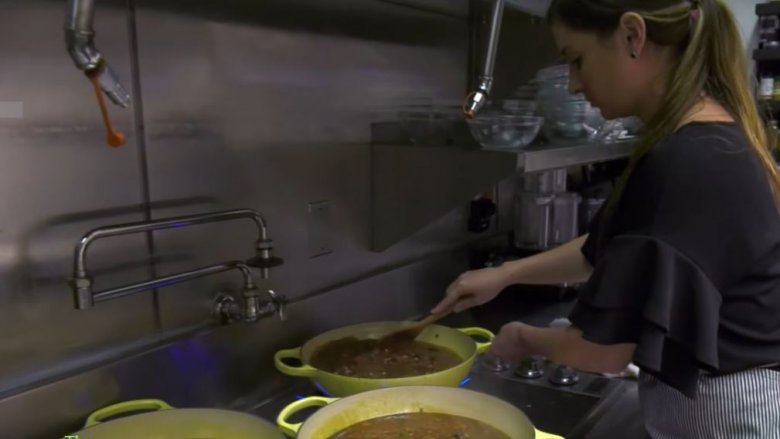What They Don't Show You On Celebrity Cooking Shows
Have you ever watched a celebrity cooking show and thought everything looked pretty simple? Maybe you even thought you could do it too, and tried to replicate the recipe. If you managed to create the same dish without a hitch, nicely done — you should probably have a cooking show of your own.
For the rest of us who gave it a shot and the dish turned out nothing like what we saw on TV — take comfort in knowing that you're not alone. It can be very misleading to see celebrity chefs make the process of creating difficult recipes look so effortless, especially when they're given such a short window of time.
So what's their secret? Are they wizards? Do they worship culinary gods? Not exactly. Turns out the chefs you see on TV have a lot (like a lot) of help and tricks to turn their short segments into a half hour of cooking power. Here's the inside scoop on what goes into your favorite cooking shows that you don't see.
Chefs make mistakes, too
Let's face it, nobody is perfect, and chefs are no exception. They may not honor the culinary gods, but they should hug their video editors often — or at least buy them coffee.
Chefs screw up plenty of times on their shows, but because of the magic of editing, you'll never actually see it happen. Your favorite host may have dropped an entire plate of lemon pepper chicken, and that steak may have ended up burnt to a crisp on one side, but all you saw was them plating the tastiness fresh from the oven.
This helps immensely with keeping the show short and sweet, but it can also be deceiving. Celebrity chefs often look like they have everything under control 110 percent of the time — and they definitely don't. This takes the humanity out of cooking. We've all slipped up in the kitchen — the same goes for the celebrity chefs out there. At the end of the day, we're all just doing our best.
The final product you see on probably isn't edible
Probably one of the saddest tricks — that glamour shot of whatever deliciousness was just cooked up? That food would probably make you sicker than a dog. Or worse.
You know those shows with glorious looking cakes that are almost too beautiful to eat? Chances are they're the devil's candy and have sat under studio lights for hours, rendering them useless for consumption without some not so great health consequences.
The same goes for that perfect looking butterball turkey that you want to duplicate for the holidays. That could very well be cooked perfectly on the outside, but is likely completely raw on the inside. Not the best gift for your friends or family this year.
Unfortunately, in the world of cooking shows, it's not what's on the inside that matters — it's really just what's on the outside. It just needs to look good on camera. So if you cooked up something that tastes amazing, but looks nothing like its fabulous cousin on screen, don't worry — you probably did it right. Bonus points if it's tasty — who's the real winner now?
The chefs have someone whispering in their ear
If you're hearing voices, you may want to consult a doctor — unless you're a celebrity chef. If the chefs on TV aren't hearing voices, they might be in big trouble.
You may not be able to see it, but most chefs are wearing an ear piece while filming so that they can receive information from the producer. This means that there's a good chance that while they're trying to walk us all through how to properly roast a duck, they're listening to their producer and making sure that they aren't blocking any shots and are smiling enough for the camera.
"What's great about the Food Network studio environment," Sunny Anderson, star of Cooking for Real told Trib Live, "is having a team where, if I miss an ingredient in the rush or forget how much time I have left, a gentle voice chimes in my ear to keep me on track." You thought they had all those recipes stored in their brains?
People are hired to clean up afterwards
No one likes to work in a messy kitchen. So it would make sense that the chefs would want to clean up after their set and make sure everything is pristine for the next show right? Wrong.
After filming, when the kitchen resembles a war-zone, chefs get to take off. When they come back for the next segment, somehow the kitchen is magically put back together and ready to be destroyed again. While a lot of people may suspect gnomes, there's a clean-up crew that is actually hired to put the disaster of a kitchen back together again.
"I'm impressed with their esprit de corps — it is a tough job," Ted Allen said of the clean-up crew for Chopped. "Chefs don't care HOW messy things get!"
It would be interesting to see if the messes got smaller if they were responsible for their own clean-up afterwards, wouldn't it?
A lot of the work is done by prep cooks
You know that moment when the chef is talking about adding chopped "insert food here" and just has a bowl of said item on hand? This is a handy tool to stay within the time window for the show, but when did they go off camera to chop everything up?
The chef isn't the only one prepping the food — they have an entire team of prep cooks that chop and prep any ingredients slated to be used that day. Most of the time, they're chopping backstage in their own private kitchen, much like sous chefs in restaurants. Their roles are pretty similar with the same end goal: Save time.
"Typically, between 15 and 20 people are involved just for the culinary elements of a basic cooking show," Michelle Betrock, publicist for the Food Network, told Trib Live. "For a bigger show like Iron Chef America, the number could be double or more."
This can also make the shows pretty misleading. Most of us don't have our own team of prep cooks to chop and mince, so don't be discouraged if you can't whip up that meal in the same time it took Bobby Flay.
The background isn't their home kitchen
Even more visual trickery here. That gorgeous kitchen you see in the background — is most likely a set or stage — not the the chef's home kitchen. With little details like books, dishes, and decor, it can be easy to feel right at home especially when the hosts are so comfortable in the space.
According to House Beautiful, this is usually because a home kitchen would have no space for the large crew — not to mention all the extra lighting that would need to be added. Fans of Nigella Lawson's At My Table were bummed to find out they're not getting a glimpse of her actual kitchen, but a set. Still, she says it's close enough. "It's filmed in a studio, copied from my kitchen, and using my own clutter," she told a fan on Twitter.
Still, some chefs do film from home... and it's not as perfect as you might think.
Ayesha Curry filmed her Food Network show, The Seasoned Life, in her home kitchen, and told People "It was a nightmare because I would hear [her children] cry and we'd have to wait for them to settle down." Though she designed her home kitchen for specifically for filming purposes, she now sees the beauty in separating work from home. She's since moved, and doesn't plan to invite the cameras into her new kitchen anytime soon.
A lot of the food gets trashed or donated
For the food that has been sitting out, dropped, or undergone any other kind of misfortune — the final destination tends to be the trash. While food waste is definitely real, thankfully most shows are able to salvage some of the food in some way so that waste isn't as bad as it could be.
Some shows will take the everything that was cooked, and will divide the food among the crew and other members. While we can only hope that this would be a calm, single file line, we can probably assume it looks more like The Hunger Games. For other food (especially food that hasn't been cooked), shows will also donate to local food pantries.
It might bring some viewers peace of mind knowing that even though the glamour shot was a waste — the rest of food has probably gone to a good place.
One quick show can take several hours to film
Competitive shows are bigger culprits than home cooking shows, but there's still a lot of time and work that goes into each episode. For competition shows, like Chopped, competitors can start their day before the sunrise and stay on set well into the night — making for a 14+ hour day of sautéing, seasonings, and stress — just to get a one-hour show
Between the judges taking their sweet time analyzing every detail of every dish, the cameras needing to get every shot perfectly , and the endless interviews that take place after the show itself — being a contestant on a competitive cooking show may not just test your cooking skills, but your patience and stamina as well. What it takes to actually put together those celebrity cooking shows we love so much is enough to make us grateful for the comfort of our couches, rather than the cutthroat kitchens.
A lot of chefs don't meet health standards
Germaphobes beware. Well, actually — everyone beware. In one recent study of 100 cooking show episodes featuring 24 different celebrity chefs, and they found some pretty gross kitchen habits. Most disturbing: Only three of the chefs were seen washing their hands after handling raw meat. Gross!
Sadly, it doesn't stop there. When it comes to washing produce, hitting the correct cooking temperature, having their hair back, and cross contamination — many food shows don't meet basic health standards in the kitchen. Some of them even did things as gross as licking their fingers, or touching their hair and then the food.
This may not seem like a big deal since they fly through the recipes anyway, but teaching food and health safety practices is just as important as teaching how to create a delicious dish. Plus they have the perfect stage to do so.
According to the authors of the study, "The behaviors modeled by the chefs could lead to incidences of foodborne illness, especially among those who mimic their behaviors at home. As potential educators of appropriate cooking behaviors, these chefs instead either ignore food safety or at best demonstrate only very limited positive behaviors." Makes you think twice about eating in their restaurants, right?
Food is swapped out during different stages of cooking
One of the biggest time savers when filming cooking shows is having the prep cooks swap out the food during the different stages of cooking. Did you actually think the chefs cook an entire meal from start to finish while the cameras watch? Not even close.
The people that chop ingredients to make them camera-ready, are also the people that cook. Prep cooks work behind the scenes with the chefs to provide examples of the same recipe at different times during filming to help keep things running smoothly.
"All the food that gets sent out to set is sent out in different stages," said The Chew's Senior Culinary Stylist Jackie Rothong. For example, when filming a steak recipe, she explained that the prep kitchen would prepare a room temperature steak, a steak ready to flip, and a rested steak that's ready to slice for the cameras.
Just one more reason the celebrity chefs can get it done with ease... they're not actually doing it at all.
